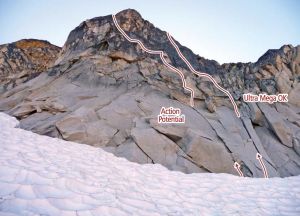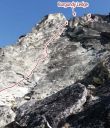Action Potential, Burgundy Spire III 5.10c |
||
Washington Pass, Washington, USA | ||
| ||
|
Avg time to climb route: 4-8 hours
Approach time: 3-5 hours Descent time: 3-5 hours Number of pitches: 8 Height of route: 800' Overview
This is a quality route with a little bit of everything. It’s a newer route and is still dirty, and while there is some loose rock, most of the route is comprised of fairly solid granite. If this route were cleaner, it would certainly be a classic. There are some death blocks to be careful of in the chimney, and while the crux pitches have been scrubbed, some they are still a little dirty. The crux, as well as everything 5.9 and harder, protects well, and the crux sports a clean fall, making it a great place for 5.10 climbers to push themselves at the grade. This climb is a fun, adventurous climb and off the beaten path.Photos
- View all 1 photos of Action Potential as: Thumbnails | Slideshow
Climber Beta on Action Potential
Find other routes like
Action Potential
Route History
Action Potential was first climbed by Mark Allen and Mike Layton on July 18-20, 2004. Allen and Layton had each spotted the potential line while climbing other peaksin the area. Then in July of 2004, they began the long hike up and over Burgundy Col and headed down to the east face of Burgundy. On their hike the pair couldn’t help wondering, “Would there be cracks or would there be compact granite seams of overlapping roofs?” The sky was leaden with dark clouds adding to the feeling of uncertainty. To their surprise, they discovered splitter white granite they couldn’t believe. The rock was better than they could have hoped for. Layton led Pitch 1, a flake that soared up the clean grey granite to a weird offwidth-like roof, but there was gear and the climbing was awesome and engaging. Then it started to rain. They questioned continuing, but as Allen seconded the pitch it stopped raining. The pair went on. Pitch 2 looked quite improbable, a series of blank looking slabs and roofs. The pair wasn’t sure the route would go any farther. Layton remembers thinking, “we’re going to be shut down?” Despite the improbable looking rock above, Allen started up and to his surprise instead of the 5.11 slab he thought he would encounter, he found an easy finger crack and yelled, “Dude, this slab has a perfect 5.7 finger crack up the center,” and then, “Dude, the headwall has a finger crack with positive holds,” and finally, “Dude, the ramp has a finger crack in it.” Everything had a finger crack. By the time Allen got to the final overhang finger crack, it had started to rain again, much harder this time. As the lichen-covered rock began to get wet, Allen began to aid. Once the thunder and lightning started, the pair rapped off and headed back down to Mazama to wait out the storm. It rained hard through the next morning and the duo headed up with overnight gear but under still ominous skies. They started climbing at 4:30 pm, not exactly an alpine start, and they knew they had to move fast. They stretched out their pitches and quickly regained their high point from the previous day. Allen did a mix of free and aid climbing on what was to become the crux of the route. Layton led the next pitch, a series of wild and spooky flakes that led to a major ledge system. After scrambling up some easier ground, Allen led a long pitch that took them most of the way up the massive chimney system that splits the upper face. Layton led the final pitch to gain the upper shoulder on Burgundy where their route now joined the 1953 Beckey Northeast Face route. They climbed the exposed ridge to the summit and finished the rappels in the dark. On the third day, Allen and Layton established a variation to their route that started on the left before crossing their route and rejoining on the right. They named their variation the Beautiful Crack and rated it III+ 5.10a. This was Allen’s first new route at Washington Pass and he named it Action Potential because he felt like it was the first of many first ascents to come. Action Potential is one of the only alpine routes that Allen established that wasn’t named after a song or album. Ironically, Action Potential is a song that was released after their first ascent. Strategy
As of the writing of this book, Action Potential has seen between seven and ten ascents. I hope that from this book the route gets more traffic and cleans up more, but the chance of crowds is slim. Because this is a newer route, many of the cracks are lichen covered and the holds are dirty. There is also still a fair bit of loose rock on the route, and you wouldn’t want to climb below another group, especially in the chimney. You can pull through the hardest sections on gear and the crux has a clean fall, but because the route is new and still a little dirty, it is only for solid mid-5.10 climbers.There is usually a short section of steep snow getting to the base of the route. Many climbers take aluminum crampons for their approach shoes and use rocks to chop steps and assist with balance. The route starts off with very clean splitter on clean granite. The start is made more easily identifiable by the small “box roof ” half way up Pitch 1. There is an awkward move pulling out of this roof, but the climbing is excellent. The double-wide cracks that start Ultra Mega OK are about five feet to the right of Action Potential. Pitch 2 looks like a bunch of blank, lichen-covered slabs and very improbable. Though not visible from the belay, there are finger cracks everywhere you need them and the pitch is much easier and better protected than it looks. The third and crux pitch starts with a couple of face moves to the crux finger crack section. The crux is well-protected and has a clean fall. It is steep and starts with a budge and some stemming, but quickly eases after about 15 feet. The crux was scrubbed by the first ascent team and has cleaned up further from subsequent ascents, but it is still a little dirty. The crux will likely continue to clean up with time. Once past the crux finger crack, the climbing eases. You finish the pitch by climbing a bunch of steep and wild looking flakes that feel a little spooky. After a short, easy pitch, comes the famous chimney. Put your belayer off to one side where he or she is less exposed to rock fall. The chimney looks harder than it is, and every time it starts to get challenging, a hold magically appears. There is certainly some loose rock in the chimney, so be careful what you pull on. You have to surmount many chockstones, and this is a long pitch, so mind your rope drag. Pitch 6 has two variations. The more obvious way is up the rotten offwidth, or take the less obvious face traverse left (strongly recommended). The offwidth has kitty litter granite and is worse than it looks. The leftward rising traverse isn’t probable looking, but goes at 5.8 with just enough protection to keep it from being run out. Once you gain the large ledge on the shoulder of Burgundy Spire, Action Potential joins the original 1953 Northeast Face route. You can down climb and finish on the more commonly climbed Northwest Face, but climbing the 1953 ridge is super fun and a great way to end the route. Stay on the ridge, passing an old bolt with an exposed 5.8 move. Finish the ridge in two to four more pitches, depending on rope drag, on mostly moderate climbing. You essentially traverse all the way across the summit ridge. There are a few exposed step across moves and some short down climbs. You’ll pass underneath the summit on the north side of Burgundy before you can climb up to the summit. Rap down the normal North Face descent to Burgundy Col. Don’t leave anything at the base, because it is a big pain to go back and get it. Retreat Storm
There are a few random bail anchors and fixed nuts, especially on the first few pitches. Once above Pitch 4, retreat becomes more difficult and having two ropes means leaving less gear.
Everything You Need to Know About
Washington Pass
Search the internet for beta on
Action Potential
|
Other Routes on Burgundy Spire
|



